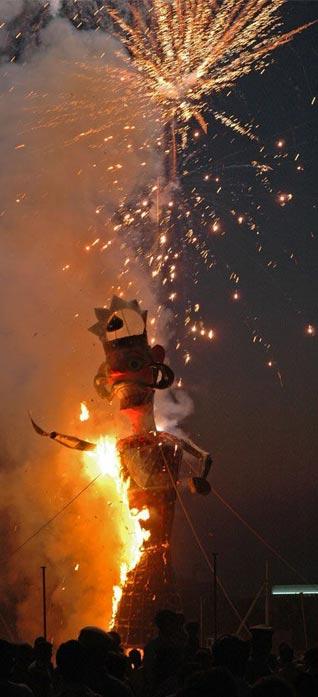Humour
This Ravan Just Wont Die
by IANS
Did the President of India recently say to the Hindus on the subject of the annual renactment of the mythical Ram and Ravan battle - which purportedly took place a few thousand years ago - that "It is time to forgive and forget. Let's all move on"?
Or does this advice only apply to the victims of the pogroms in India 25+ years ago?
Instead of getting killed, he stormed off the battlefield, leaving the Ramayan saga incomplete at a famous Ram Lila in Agra, India, the other day.
But
now the actor who played Ravan says he had a perfectly good reason for it - undue favours to Ram and his retinue at the cost of the King of Lanka and his army!
Raju, who plays the demon king, says he was protesting the "lack of respect to Ravan" by the Ram Lila organising committee when he refused to let his character die on stage - in complete contravention of the epic drama being enacted on the grounds opposite Agra Fort on Sunday night.
"The Ram Lila committee has not been giving due respect to Ravan and denying even basic facilities to me and my volunteers," said Raju, alias Virendra Kumar.
Most people who were witness to the high drama said Raju was loving the limelight and refused to give in to pressure from the organising
committee to let Ravan die an early death.
But Raju said in his defence: "A lot of things were lost in the din
and noise and a clear picture of what exactly happened right there in the middle got distorted."
This was the first time in the more than 100 year history of the Ram Lila enactmenmt that Ravan had not been killed. Raju even pulled out a sword and the actors representing the two armies of Ram and Ravan got involved in a fight for a few minutes - much to the amusement of spectators.
Raju eventually disappeared from the scene!
"Ravan not getting killed is a gross injustice to artists," Raju
admitted, though without explaining why he ran away from the
battlefield. "Ravan should have been killed. This has happened for
the first time in the history of Agra's Ram Lila," Raju said.
"For 100 years, eight generations of our family have been performing
this drama as a matter of responsibility, following all the norms and rituals. But surely there is a limit to tolerating injustice.
"While the Ram Lila committee spends hindreds of thousands of rupees on Ram and his 'mandli' (group), they spend nothing on us. They do not even provide
us drinking water. I do not know how they spend the funds.
"After Raksha Bandhan, our team of more than 80 volunteers start practicing martial arts, our Patwari Akhara's 'pattebazi' is unique. Sunday night I was there with 120 in my army and those organisers were playing dirty politics.
"They did not respond to our demands and called us all kinds of names. We kept our cool, but when things really got out of hand we had to protest."
In many ways, the line between real life and the myth has become blurred for Raju. For, like every year, his family will perform a death ritual for Ravan this year too.
Raju said the coming Sunday "the family is going to hold the 'terehnvi' (13th day after death) of Ravan by throwing a feast for those associated with the tradition."
Raju is a businessman who makes iron shoe moulds. "We participate in the Ram Lila to keep a convention alive and for our love of the art. But now I have announced my dissociation. I have informed the Ram Lila committee that in future we would not be able to give our services," Raju said.
Raju has his fans.
Culture critic Mahesh Dhakar said: "It's a wonderful sight to see Ravan and his army swinging and brandishing swords in a special display of pattebazi (a form of their self developed martial arts) practised by the family for over 100 years."
October 22, 2010
Conversation about this article
1: Bibek Singh (Jersey City, U.S.A.), October 22, 2010, 12:10 PM.
Very brave of Mr Raju indeed! In my ninth standard, I was asked to play the role of 'Raja' Ram in a play. They selected me due to my 'joorrah'. The story was that a group of artists was planning to perform Ram-Lila. The members performed 'n' rounds of rehearsal. At the end of every rehearsal, the person who was supposed to play the character of Ravan reminded the director/ producers to pay his previous balance. Every time he was assured of the same but somehow he did not get his cheque till the final show. During the actual Ram-Lila, he therefore refused to die. Ram tried different options, such as Brahma-astra, etc., but in vain. The director of the Ram-Lila then managed to reach the stage (in the form of Vibheshan) and recommended to Ram (i.e., me) to use the 'Money-baan'. This 'Money-baan' was an arrow with a cheque of Ravana's previous amount attached to it. As soon as Ravan saw the arrow and its payload, he gladly died on the stage. It was a very funny play. Every Ravan looks for something genuine and deserving. If we are somehow able to meet his demands, he would gladly leave the stage and would no longer be part of the problem. Nice strategy ... huh! Can we use this strategy in dealing with some of the modern-day Ravans of India?
2: Kanwarjeet Singh (Franklin Park., New Jersey, U.S.A.), October 22, 2010, 4:49 PM.
Ever since childhood, whenever I heard the short description of the Ramayan, I was always convinced that the message was more than just, 'Ram conquered Lanka and Ravan' or that 'truth prevails' - (by the way this principle ironically seems to defy itself within the borders of India). As I experienced life, I realized and theorized that Ravan and his ten heads actually were Valmiki's representation of ten bad qualities or evils within a human being - namely: ego, anger, lust, greed, and so on. Ram, on the other hand, represented truth, and what Valmiki was trying to say was that using this truth, a human can successfully conquer those evils. Now our Gurus made it even simpler; they also clarified to us that the term 'Ram' used in spiritual parlance was not Ran, the king of Ayodhya, but the power of eternal truth which is Waheguru Himself/ Herself. Unfortunatley, just as Hindus got stuck with the characters of the epic over centuries, many Sikhs today are stuck over similiar trivial issues (the list is too long to pen down here). Our Gurus' message as enshrined in gurbani is very simple: to improve one's life, we will absolutely need to use the assistance of Waheguru and with His help one can conquer all evils.
3: Sangat Singh (Kuala Lumpur, Malaysia), October 22, 2010, 7:40 PM.
I have often wondered how Bapu Gandhi would have dealt with such an explosive and violent situation (the Ramayan story and its re-enactments), and how he would have given a non-violent twist to the time worn conventional script. I suppose the usual esoteric explanation one could provide was that it really didn't happen. It was just the inner conflict where the demons resided that you could of course kill them non-violently if you so pleased by holding your breath long enough until you turned blue. Good for Mr. Ravan for allowing him to die as a common mortal in the ripeness of time. I believe there is a large Hindu community in South India which worships Ravan, and they celebrate Ravan-ashtami. Congratulations to Mr. Raju for his lateral thinking.
4: Mohan Singh (Toronto, Ontario, Canada.), October 23, 2010, 1:12 PM.
Ten heads of Ravan are projected as symbolic, and that represents 10-fold power of knowledge, wisdom, devotion and thinking, etc. as compared to other, ordinary brahmins. Reference to Ram in gurbani refers to the One God, as people use to worship Ram even in Satyug, long before before Treta, when the Ram of Ayodhya was not even born. In gurbani, there is also reference to the mythological King Janak as Mahan Bhagat, who also used to worship Ram, the ONE GOD, and not his son in law, Ram Chandar Dasrath Lal of Ayodhya. The celebration around the re-enactment of the Ramayan story of the Ayodhya family, known as 'Ram Lila', is not just 100 years, but probably much longer. Guru Nanak says in Asa di Vaar: "The disciples play the music, and the teachers dance. They move their feet and roll their heads. The dust flies and falls upon their hair. Beholding them, the people laugh, and then go home. They beat the drums for the sake of bread. They throw themselves upon the ground. They sing of the milkmaids, they sing of the Krishnas. They sing of Sitas and Rams and kings. The Lord is fearless and formless; His Name is True. The entire universe is His Creation." Further, Nanak says: "The Lord binds us in bondage - so do we spin around. According to their actions, so do all people dance. Those who dance and dance and laugh shall weep on their ultimate departure. They dance and jump around on the urgings of their minds. O Nanak, those whose minds are filled with the Fear of God, have the love of God in their minds as well." [GGS:465].






